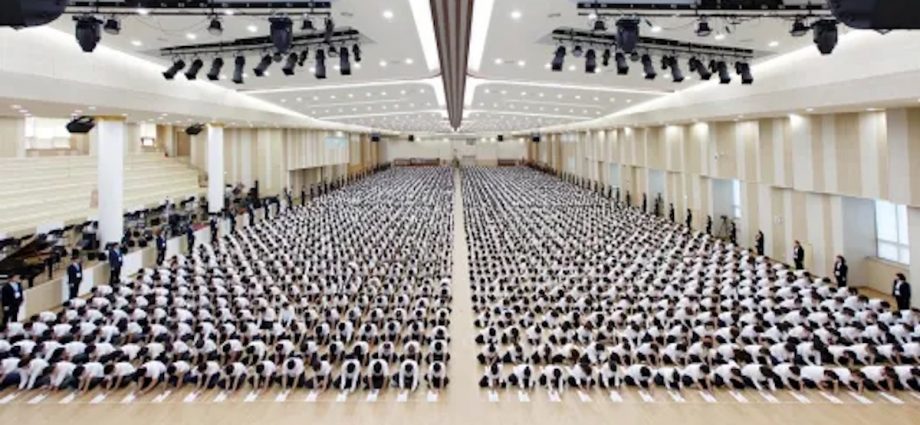“Calling a stag a horse” is a proverbial expression in Chinese. Zhao Gao was the corrupt prime minister of the second emperor of unified China, who reigned at the end of the third century BCE. Zhao planned to usurp the throne but needed to know who in the court would support him. So, he presented the emperor with a stag and called it a horse.
When the emperor objected it was indeed a stag, Zhao asked the courtiers to confirm it was a horse. Many did, as they were afraid of Zhao. He had those who insisted the stag was a stag beheaded and proceeded with his coup.
“Calling a stag a horse,” or turning the meaning of the words upside down for evil purposes, is often done today to discriminate against religious minorities. When they become victims of crimes, it is suggested that it is their fault. The victims are called aggressors, and vice versa. It is reminiscent of an old strategy of shyster lawyers who defend rapists. They invariably blame the raped woman, who perhaps did not dress modestly enough.
This year on June 16 in South Korea a man killed his ex-wife and the wife of his ex-brother-in-law, seriously wounding the latter. Although personal reasons might have been his main motivation, he claimed he had committed the crime because the wife was a member of a new religious movement called Shincheonji.
Twenty-four hours before the crime, the assassin had consulted with the Heresy Research Center, an organization specialized in fighting groups it regards as heretic “cults.” The Center did not suggest that the man commit murder but did excite his hatred against Shincheonji.
After the crime, the center called a press conference claiming that the murderer was the victim, and Shincheonji was responsible. Had his wife not joined Shincheonji, they said, the poor man would not have had to spend the rest of his life in jail, a likely outcome of his case.

On January 3, 2019, a teenager entered the premises of the Church of Scientology, of which his mother was a member, in Sydney, Australia, and fatally wounded a Scientologist with a knife. At trial, he was later recognized as not criminally responsible, as two experts pronounced him schizophrenic – but real paranoids have real enemies.
Although he had quarreled with his mother for different reasons, propaganda depicting Scientology as evil may also have excited his feeble mind. Anti-Scientologists told the media, without shedding a tear for the victim, that Scientology was to blame for having allegedly created hostility between mother and son.
The Abe assassination
Whatever one may think of Shincheonji or Scientology, these are egregious cases of turning the victims into perpetrators. And now we have the most spectacular case of this twisted logic of them all, the murder of Shinzo Abe. Let’s consider five basic facts.
First, the assassin, Tetsuya Yamagami, was not and had never been a member of the Unification Church, now called the Family Federation for World Peace and Unification.
Second, Yamagami’s mother did join the Unification Church in 1998 and is still there. She declared bankruptcy in 2002, a fact both Abe’s killer and her brother-in-law blamed on the excessive donations she made to the Church. After the brother-in-law complained, two Church members returned in installments 50% of the donations.
Third, Shinzo Abe was not a member of the Unification Church either. He participated through video to a 2021 event, and send a message to another event in 2022, of the Universal Peace Federation, a NGO founded by the leaders of the Unification Church. So did Donald Trump, former European Commission presidents José Manuel Barroso and Romano Prodi, and dozens of other politicians of all persuasions.
Fourrth, his mother’s bankruptcy, as he reported himself, caused Yamagami’s hatred for the Unification Church. However, the bankruptcy occurred in 2002 and Yamagami killed Abe in 2022, twenty years later.
What triggered Yamagami’s killing frenzy in 2022, and not before? We know for a fact that Yamagami followed the hate campaigns against the Unification Church prevailing in Japan. He interacted on social media with fellow enemies of the Church.
The day before killing Abe, Yamagami wrote a letter to Kazuhiro Yonemoto. Although Yonemoto deserves credit for having opposed in the past the practice of kidnapping members of the Unification Church for the purposes of deprogramming or “de-converting” them, he remains an opponent of the Church. Yamagami interacted with the anti-Unification-Church milieu and was exposed to hate speech against the Church, which may easily have turned his weak head.
Fifth, before killing Abe, Yamagami had planned to assassinate Hak Ja Han Moon, the leader of the Family Federation, and he tested his weapon by shooting at a building that had once been used as a Family Federation church.

Yamagami hated the Church, and this hate was fueled by the hate speech of the anti-Unification-Church activists. To hide their responsibility, they blamed the Unification Church, which was clearly a victim, as if it were the perpetrator.
Twisting words has dire consequences. After calling a stag a horse, Zhao Gao had an ephemeral success but ended up causing the ruin of the Qin dynasty and being killed himself.
Calling the victims perpetrators and the perpetrators victims has a similar destructive social potential – one that those who manipulate the facts of the Abe assassination to advance their anti-Unification-Church agenda should perhaps pause to consider.
Massimo Introvigne is an Italian sociologist of religions. The author of some 70 books, he is the founder and managing director of the Center for Studies on New Religion (CESNUR), an international network of scholars.
This article is excerpted, with kind permission, from a seven-part series previously published by Bitter Winter: A Magazine on Religious Liberty and Human Rights.

